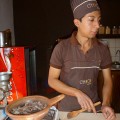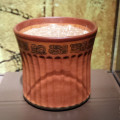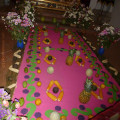As an American, we eat so much chocolate, but rarely think of where it comes from or how it is made. That is why I decided to visit the Choco Museo in Antigua, Guatemala. Beyond learning about the history of chocolate and its uses over time I was more fascinated to simply learn about where chocolate comes from!
Chocolate is from the cacao tree. This tree is very picky on where it lives, and only grows in certain parts of Central & South America, the Caribbean, West Africa, and a few plantations in Asia. There are also different types of cacao trees which produce different tasting chocolate.
It was strange seeing the extremely small flowers that grow to become cacao pods, not from branches but directly from the trunk of the tree. These pods are really the fruit of the tree which are harvested and cut open to allow the beans and pulp to ferment for up to 9 days in the heat. This helps to give chocolate its brown color and flavor.

Dried Cacao Beans
Afterwards, the beans are separated from what is left the bitter white pulp of the fruit and allowed to dry in the sun, which can take up to 7 days.

Cacao Shells or Husks
Next the beans are then roasted, to lessen their water content to help get them out of the shells. The de-husking process is called winnowing. Shells are lighter than the “nibs” inside. Nibs are what will then be used to make chocolate, although some people use the shells for other uses like cacao tea or fertilizer.

Cacao “Nibs”. You can eat these raw but they are bitter, or can start the grinding process to make chocolate.
The nibs are ground down, and make a paste called cacao liquor which is made up of around 50% cacao butter and 50% cacao solids. After grinding you can press the chocolate liquor with enough friction and separate these two parts. Cacao butter is used in chocolates but has other uses like cosmetics or medicine. The cacao solids are often grounded down into a powder, which is used to make chocolate beverages or baking.

Grounded Cacao Nibs, starting to form Cacao Liquor.
To make what we know as chocolate you mix the cacao liquor with various percentages of cacao butter, sugar, milk, and other spices. But you must be sure refine the mixture to make sure the chocolate’s texture isn’t too grainy or too pasty. This mixture must be frequently agitated to give chocolate its silky texture, this is called “conching” and can take a few days. But do it too much and you’ll ruin the consistency.
When it is time to use the mixture, you must first temper the chocolate by cooling and warming it repeatedly. This is what gives chocolate its snap, glossy sheen, and its proper melting consistency. Now the chocolate is ready to be used, for example set in molds to form candy.

Chocolate for Sale at the Choco Museo in Antigua, Guatemala.
If you go:
It is located 1.5 blocks off the central square.
Check the website to see hours.
Displays are in English and Spanish.
Museum Monday is an every other week series about museum news, objects, and reviews.
(And yes I know I switched up the schedule the last 2 weeks.)






Leave a Reply